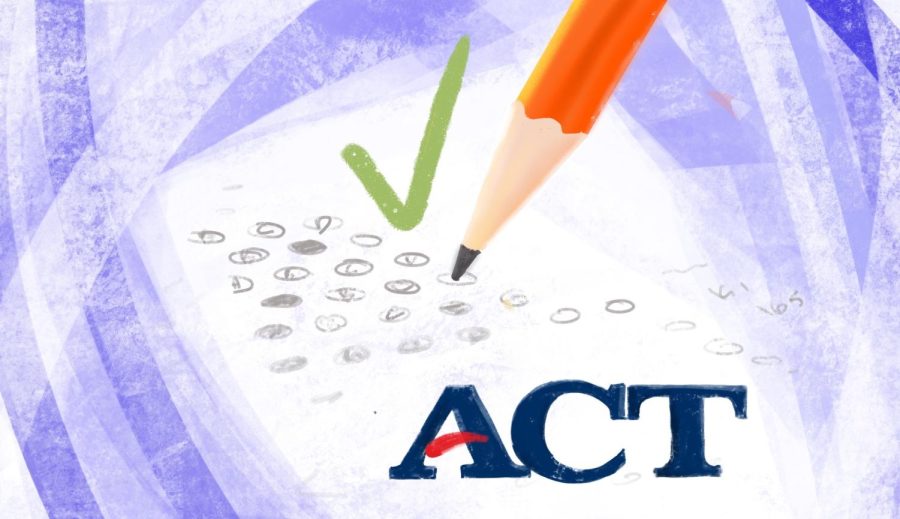Common Sense’s common sense tips and tricks to ace the ACT
Mar 13, 2023
From scholarships to pride, the results of your ACT test can hold a lot of weight. The collective stress of the ACT can make many juniors fret, but fear not! Common Sense is here to prepare you.
First, let’s look at the test as a whole and the general preparation needed for it. For many, there is a justified amount of fear when it comes to taking the ACT, but there are a few things that you can control to set yourself up for success. For one, before you take your test, allow your body to be completely charged. Aden Williams, a senior who achieved a 35, focused on preparing his body for the long battle of taking the ACT.
“I got like nine hours of sleep,” Williams said, “So it was nice to be well rested and highly energized for the day.”
Audrey Spahr, another senior who achieved a 34, emphasized the importance of a good breakfast.
“I definitely recommend eating breakfast and having a coffee,” said Spahr, “For breakfast I definitely recommend oatmeal with either banana or apple slices and cinnamon.”
Sleep and a good breakfast can prepare your body, but what about your brain? Ultimately, the old adage still rings true: Practice makes perfect. In this case, the internet is your friend, as practice tests and practice questions are abundant. Junior Neely Edwards utilized these online practice tests to earn her score of 31.
“I just took a bunch of practice tests to see what I did wrong,” Edwards said, “Then I focused on the sections I needed to.”
Practicing allows you to fully understand which sections need the majority of your attention. This will be different for everyone, hence the different strategies for each test.
Additionally, whether you like it or not, John Baylor isn’t lying. There is a reason why Millard pays him money to help teach you how to take the ACT and it is a privilege not had by many in the country.
“He did a good job of giving me like the little things,” Spahr said, “And once you learn them, I feel like you can memorize them pretty easily and just apply them to the test you’re taking.”
With the general preparation out of the way, let’s look at some of the in-depth strategies for each section of the test.
Math is the first section and has a few key strategies to maximize your score. The math section is unique in that the questions become increasingly difficult as you progress. Additionally, you are being tested over a wide range of high school level math subjects, some of which you may not have been taught in years. Senior Wesley Earhart scored a 33 and recommended jumping around the section.
“The thing is you best understand the thing you did most recently,” said Earhart, “So I would say really, really jump around in the math section.”
Earhart also recommends utilizing the highest power calculator permitted: a TI-84.
“If you bring a TI-84 calculator, it is honestly incredibly unfair how much of an advantage you have,” he said, “There was a button on there for like half of the questions.”
Ti-84 calculators are available for purchase or rent, and students can usually ask math teachers to borrow one for the test. Aden Williams adds that students should pick their battles in the math section and focus on the early questions before worrying about the later ones.
“So make sure that you’re really really solid on those first 50 Especially those first 30,” Williams said, “You should aim for 30 out of 30 on those first questions. So review your algebra, review your like annoying geometry stuff, and it’ll help you a lot and reread the question because you don’t want to get tripped up with a silly mistake.”
The second section is the English section. This is where John Baylor truly shines as his “Hammer the Grammar” slogan can knock some sense into you. Braytn Nespor, a senior who earned a 32, said, “one of the best things to do for English is just John Baylor.”
Another senior, Will Cameron, achieved a 34 and got a 36 on his English section.
“[John Baylor] can teach you English because it’s just 20 tricks,” Cameron said, “Learn the tricks and you’ll do much better.”
Aden Williams said, “There are a lot of things about the ACT that are difficult to study for, but the English section is not one of them.”
Before the third section, there is a break to rest your brain before the final two sections. This break is paramount in avoiding test fatigue, which has killed many test scores in the past.
“I had a lot of test fatigue,” Spahr said, “Do anything that you can do during your break to have the least amount of test fatigue possible. So whether it’s like running a lap around the school or whatever it is, just do it so you can go into the reading section feeling confident,” she said.
After the break, you will take the reading section. This is a difficult section to study for, but there are a few tips to rely on. Wesley Earhart scored a 36 on his reading section and suggests using the multiple choice format to your advantage.
“It’s a multiple choice test,” Earhart said, “So like if you just kind of look through the first and the last paragraph or the overall thing, you can kind of get a feel of what the summary of it is. And because it’s multiple choice, I think you can get a pretty good grasp on what it’s like if you’re struggling with time,” he said.
Will Cameron utilized a unique tactic to achieve his 31 on the reading section. Cameron read through the first few passages and attempted to ace those questions and then skimmed the final passages.
“So if you just fully read most of the passages,” Cameron said, “You’ll be able to guess on the last ones.”
The final section is the science section. It is similar to the reading section in that it has a lot of text, but the text is less essential.
“Never start by reading the description of the experiment,” Aden Williams said, “You can always go back and find that later.”
The science section has a lot of fluff and that fluff can be very confusing. With the specific language used in the text, it is okay to cross those words out and insert a more familiar term.
“You don’t have to know what’s happening,” Braytn Nespor said, “So just pretend that you get all the information you need.”
The test is set up so that you can actually answer the questions. Most answers are found in the specific graphs, and if they aren’t, they are typically something you should know easily.
Wesley Earhart said, “Almost every science question you are given the tools to do well on without needing a lot of external resources.”
Apart from the math section, the science section is the best section to use your pencil on. You can cross out too specific terminology and for those tricky multiple scientist or multiple experiment questions, writing down the main points of difference help tremendously.
Ultimately, the main determining factor of a good ACT score is practice. The more times you take it, the better you will be. Millard students are lucky to receive a free test, but if you don’t get the score you want, try again. The cost of a single ACT test is $60, but it will pay itself off easily. Wesley Earhart took the ACT 4 times before he was happy with his score.
“If you take the ACT more often the chances you’re gonna eventually get something that fits you a lot more,” Earhart said, “I just got like $20,000 in scholarships from my ACT score, so it’s worth the maybe $200 I put in.”


